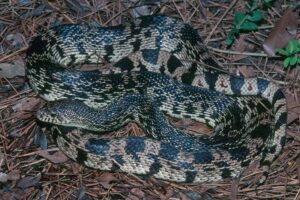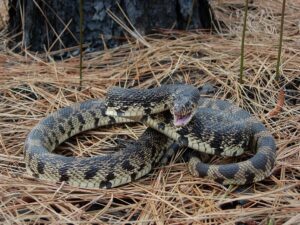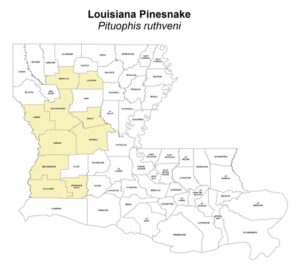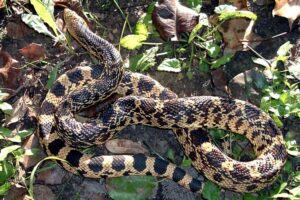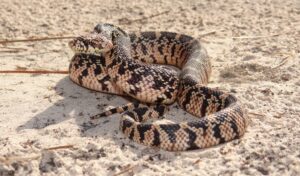The Louisiana pine snake is a large constrictor belonging to the family Colubridae. The species is unique for its large eggs and small clutch sizes. Being one of the rarest snakes of North America, it is rarely found in the wild. The ruthveni in its scientific name is in honor of Alexander Grant Ruthven, late herpetologist of the University of Michigan Museum of Zoology.
Scientific Classifications
- Suborder:Serpentes
- Family:Colubridae
- Genus:Pituophis
- Species:P. ruthveni
Conservation Status
Description
Size
The adults get as big as 48-90 in (120-230 cm) in total length, including the tail.
Color and Appearance
The dorsal color is lion-like yellow or buff with dark brown spots and blotches that look similar in all parts of the body. However, the marking pattern varies from one end of the body to another. It is denser in the neck region where the dark marks reticulate and blend more with the light ground color. Towards the midbody, the dark marks become more distinct and contrasting. They continue to be so towards the tail but get reduced in thickness. 28-42 marks occur mid-dorsally.
The extremely pointed head can have slight markings in the form of small dots and a faded bar between and in front of the orbitals above. The ventrals have intermediate brown blotches. But there is no checkered pattern. There are 8 or 9 supralabials and 10-15 (usually 14) infrabials. The rostral scale is highly enlarged.
Are They Dangerous to Humans
When disturbed, the serpent hisses loudly, flattens its head and vibrates its tail. But it is non-venomous and harmless.
Louisiana Pine Snakes at a Glance
Distribution
It is endemic to west-central Louisiana and East Texas.
Habitat
The Louisiana pine snake is usually associated with sandy, well-drained soils of open pine forests, especially longleaf pine savannahs, with a well-developed herbaceous understory dominated by grasses and moderate to sparse midstory. It is most active on low, broad ridges covered with sandy soils.
They spend at least 60% of their time below the ground showing only short-range movements of 10-20 ft (3-6.1 m). They go underground at least once during the day, possibly for body cooling, foraging, and avoiding predators. They are most active in the late morning and mid-afternoon and least active during the night and early morning. Hibernation always takes place in pocket gopher burrow systems.
Season-wise, they are most active from March to May, especially in November. They are least active from December to February (during hibernation) and in summer, especially in August.
Lifespan
The average lifespan of the pine snake in the wild is unknown. In captivity, it can live for more than 20 years.
Predators
The Louisiana pinesnake’s predators are mostly large mammals.
Diet
Baird’s pocket gophers are its primary food source. But it also eats amphibians, cottontails, rodents, ground-nesting birds and eggs.
Reproduction
Oviparous (lays eggs that hatch outside the body)
The gestation period is around 21 days, and then the incubation occurs for 60 days. The remarkably low reproductive rate amplifies the population threat to the species. They have the smallest clutch size (3-5) of all North American colubrids and the largest eggs, generally 5 in (13 cm) in length and 2 in (5.1 cm) in width.
The hatchlings are also the biggest having a total length of 18-22 in (46-56 cm) and a weight of 0.8 oz (23 g). The huge size of the hatchlings might be an adaptation to allow the young to start feeding relatively early. The snakes reach sexual maturity at a minimum age of 3 years when they are of a total length of 4 ft (120 cm).
FAQs
Ans. There are around 200 individuals estimated to be left in the wild.
Ans. It is endangered due to its low fecundity combined with extensive habitat loss. Management activities are being carried out to recover its numbers.
Source
eol.org, inaturalist.org, louisianaherps.com, calphotos.berkeley.edu, louisianaherps.com

